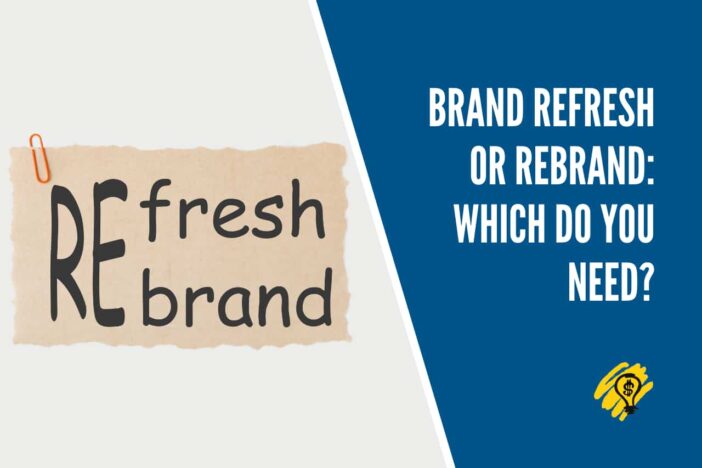A lot of businesses will get to a point where they feel like they need to make a change, but they aren’t sure if that means an entirely new brand strategy or a brand refresh.
Both can revive the performance of your business when used appropriately and done well, but how do you know which one is right for you?
The following comparisons can help you determine whether a refresh or rebrand could be the appropriate option.
What’s a Brand Refresh?
A brand refresh is when you reimagine the look and feel of your brand. You can create a new face for your brand if it’s overall strong but at the same time feels like it could be outdated or maybe stale.
For the most part, a refresh will center around visual identity, but there are certain circumstances where it might also include your culture, products, systems, or services.
As a tactical move, a brand refresh is a good way to make sure that you’re keeping up with the current trends in the marketplace. Otherwise, the alternative can become that you’re stagnant while your competitors are reinventing themselves. You’ll l quickly lose your competitive edge if that’s the case.
What is a Rebrand?
On the other hand, a rebrand is a complete company repositioning. When you undergo a rebrand, you are updating your brand in a completely fundamental way. It’s something you might undertake if you’re struggling with systemic issues that come with growth, you’re facing a major PR disaster, or you’re in the midst of a shift in your business model.
When you go through the process of a rebrand, you’re eliminating what your brand was and focusing on what it can be.
This is a good move for brands that aren’t sustainable anymore as they are presently.
When you rebrand, you’re indicating to the marketplace that you’re taking on a new strategy. You’re going to be following a new course in the future.
A rebrand, as such, is going to be more time-consuming and cost more, but for some brands, it’s more than worth it in terms of ROI.
The Benefits of a Refresh
If you’re thinking about a brand refresh, benefits can include:
- You can create buzz. That’s perhaps one of the fastest results you’ll see with a refresh—you’re giving people something to talk about. It could be simply a new tagline, serving as a reminder your brand exists and showing that you’re still relevant to the needs of your targeted customers. You might also be able to garner the attention of new customers too.
- Increasing sales. If you do a brand refresh, you’re putting yourself front and center in the minds of current and possibly new customers, which can increase your sales. The more people are thinking about your brand, the more likely they are going to buy from you versus your competitors.
- With a refresh, you might be able to raise your prices but do so in a way that will seem justified. It’s hard to ask people to pay more for the same old thing.
- Boost retention. Yes, attracting new customers is important, but it’s also important to retain them. When you can show brand refresh signals to your current customers, it indicates your comfortable evolving to meet their changing needs. Customers like to feel that they’re associating with relevant, modern brands.
- Attract great employees. One of the biggest challenges for a lot of businesses right now is attracting top talent. When you refresh, you can also use it as an opportunity to spruce up your employer brand at the same time. Employees, just like customers, want to associate with exciting, leading-edge companies.
When Should You Do a Refresh?
Most companies should consider a standardized timetable of doing a refresh of their brand every three to five years. If you’re a consumer products-based brand, you might need to do so more often to stay relevant.
Some of the signs that you should consider a refresh of your brand include:
- Your brand looks or feels outdated. It’s fairly easy to recognize an outdated brand—you don’t need to bring in an expert to tell you this is the case.
- There’s inconsistency across touchpoints. If all of the pieces of your marketing approach seem like they were created by different companies, you can refresh simply by building something more consistent and cohesive.
- Your competition is growing. When there is a growing threat encroaching on your business from the competitors, it can be a good sign it’s time for a refresh.
- If your marketing isn’t performing the way it should or you need it to, it may be a red flag that you need a refresh. Underperforming marketing can be due to reasons like a brand that no longer is able to resonate with the targeted audience.
- You want to grow your appeal to new audiences. Maybe you want to capture the attention of a younger or older audience, for example, meaning you need to make sure your brand reflects them.
What’s Involved in a Refresh?
There are a lot of ways you can integrate a refresh into your branding. It tends to be a smaller-scale project than a complete overhaul, of course.
To be successful in a refresh, you want to make sure you start with research. You need to understand the current needs of customers before you can start to revamp your brand in a way that’s going to resonate with them.
You want to account for everything included in your brand strategy, like your brand personality and key differentiators. Take a look and determine whether they need an adjustment or a full update.
Finally, the most critical work in most brand refreshes is about your visual identity. You might be able to do a refresh by changing up your logo and color scheme because these are those immediate things that customers see, and they have that initial impact.
Once you’ve done the work you want everyone to see, you reintroduce your brand to the world in a proactive way, going where your customers and targeted customers are most likely to be. Some call this a brand activation campaign meant to get attention.





